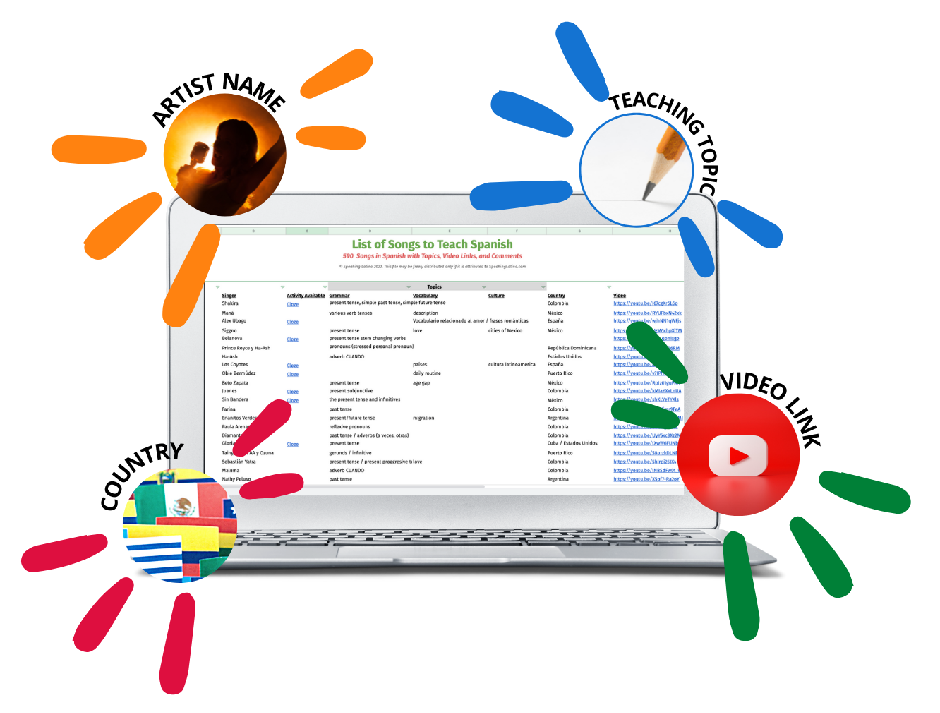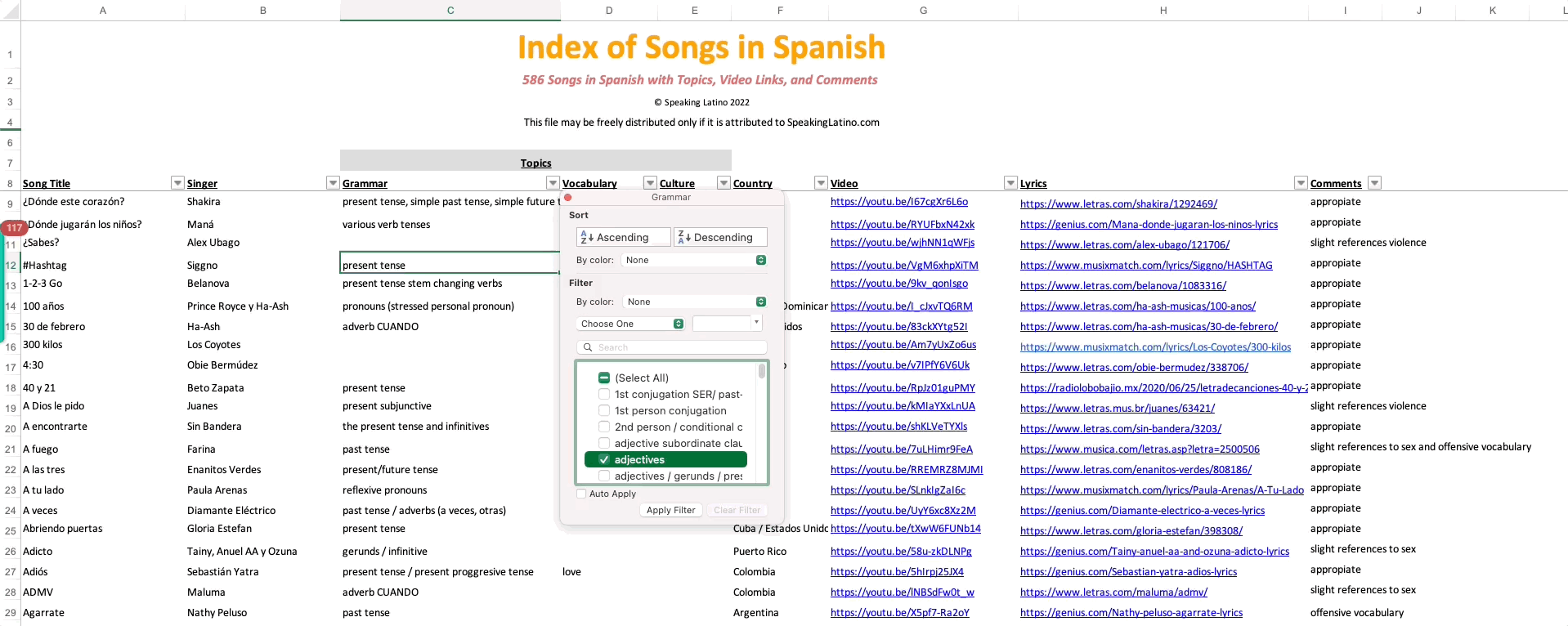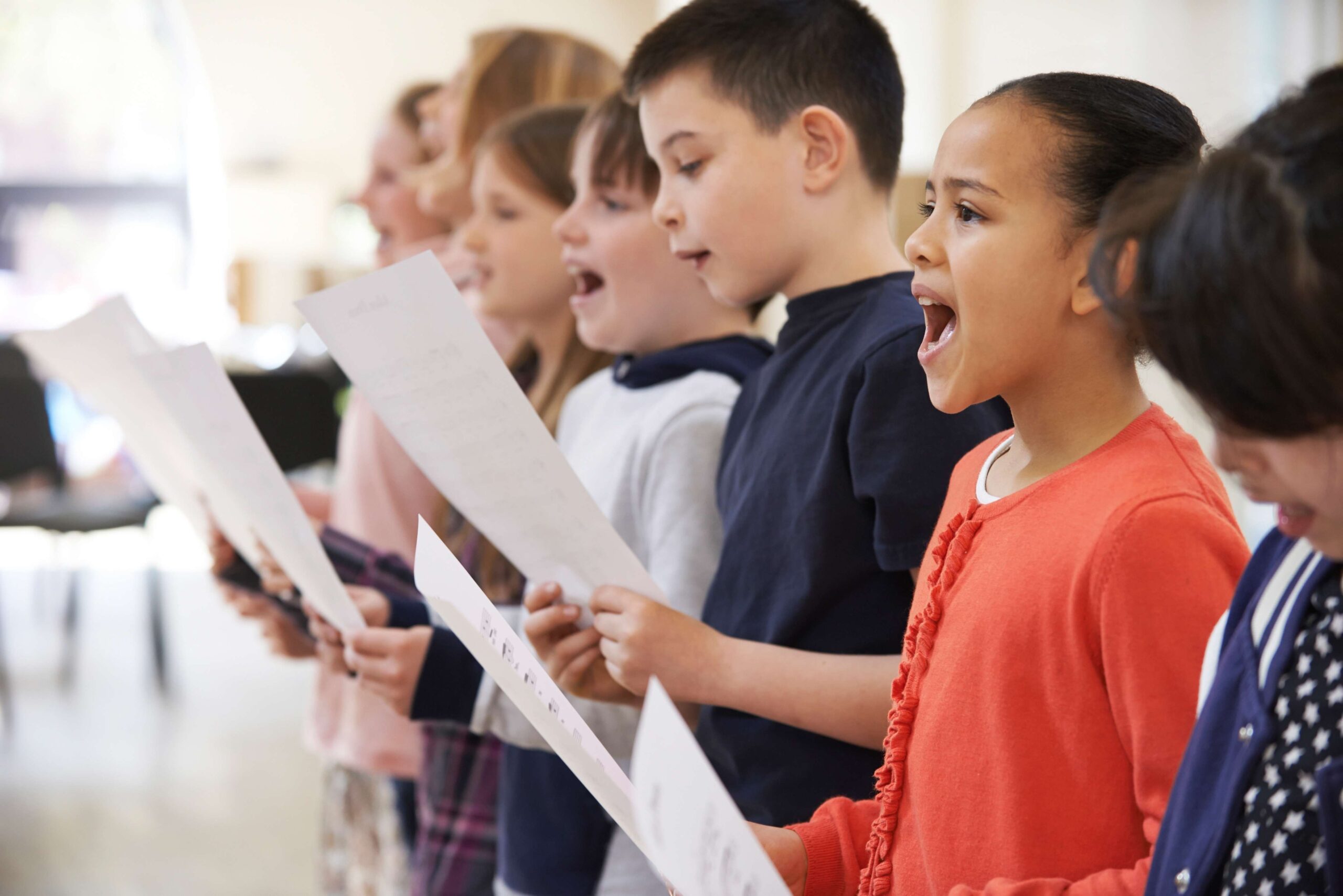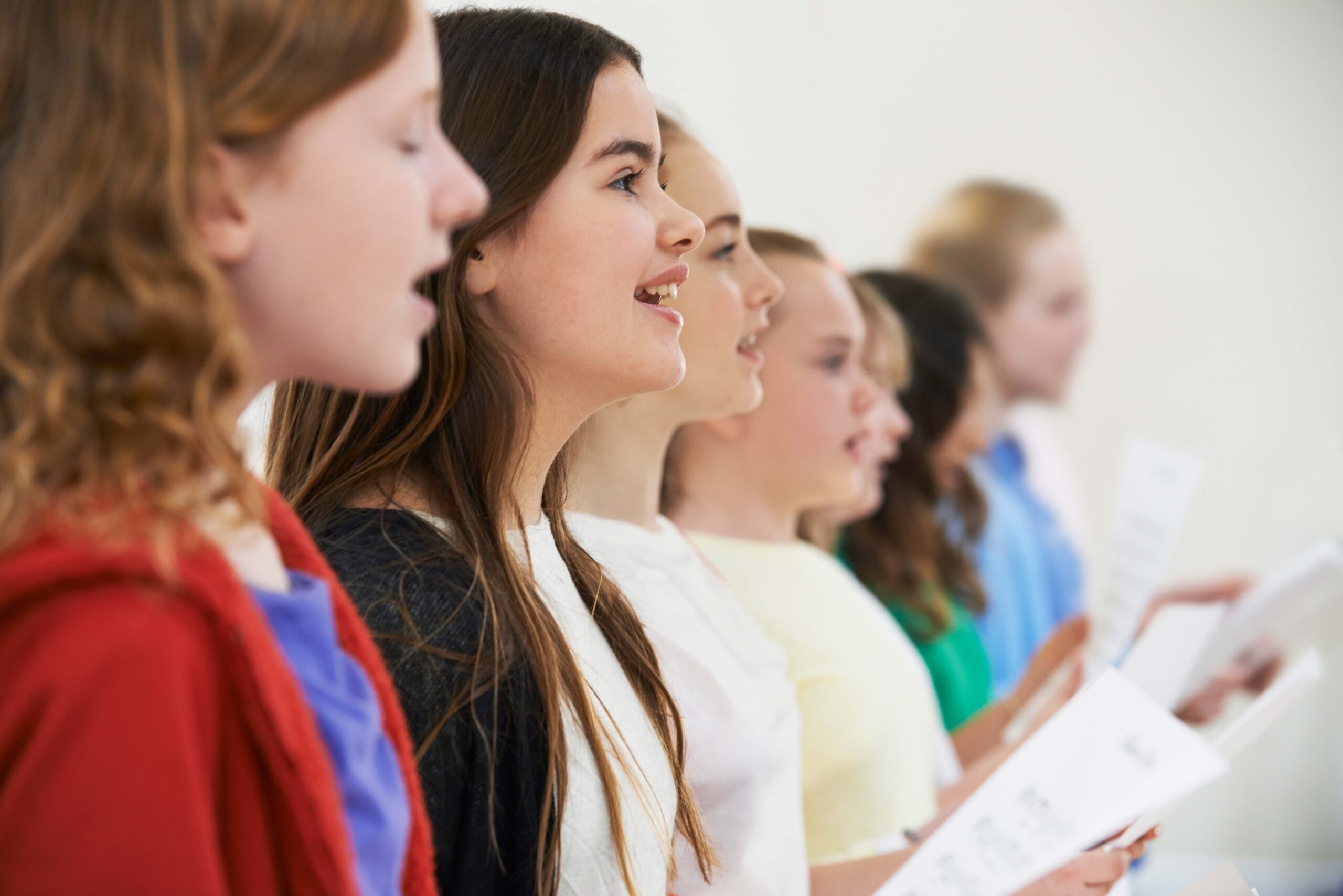
Spending Too Much Time Searching for Songs for Your Next Spanish Class?
Grab our mega list of 590 authentic contemporary songs for your Spanish class with teaching topics, video links, and annotations to help you find what you need in minutes... not hours!
Enter your info to receive it now 👇
Spending Too Much Time Searching for Songs for Your Next Spanish Class?
Grab our mega list of 590 authentic contemporary songs for your Spanish class with teaching topics, video links, and annotations to help you find what you need in minutes... not hours!
Enter your info to receive it now 👇

Teaching Spanish With Songs is Fun... But Wasting Hours Researching is Not!
The leg-work is done for you! With this curated MEGA list, you will easily find school-appropriate Spanish songs for any student's level!

Learning Spanish with Songs is Fun... But Wasting Hours Researching is Not!

The leg-work is done for you! With this curated MEGA list, you will easily find school-appropriate Spanish songs for any student's level!
Find the Next Hit Song for Your Students!
STEP 1
Tell us where to send you the Mega Song List by filling out the form above.
STEP 2
Receive the Google spreadsheet via email instantly.
Check your inbox, promotions, or spam folders!
STEP 3
Filter or sort at your convenience to quickly find clean Spanish songs for school that your students will love!
If your students love working with Spanish songs in class, then get this curated list to cut your research time!
Students will be more engaged, and you’ll always be ready to deliver memorable lessons!
Meet Your Teacher Friends
Diana is from Puerto Rico, Jared is from the US, and together we wrote 12 books on the Spanish unique to each country (¡nos encanta!).
We first started creating Spanish lesson plans to help Diana’s sister reduce her prep & planning time. When other teachers approached us to do the same for them, we knew we wanted to help as many teachers as possible.

Jared and Diana, Speaking Latino Spanish Teachers Community
Now we get comments like:
My eighth graders were captivated by the song. Some have started listening to it on their own devices. -Katherine G.
They loved that we did this to review boot verbs. -María S.
I used this resource for Level 3 and 4 students. I teach hybrid and it was a perfect lesson to incorporate culture, music, and grammar practice. Está perfecto y lo recomiendo. -K. Sabattini
Songs for Teaching Spanish
Listening to music is a fun way to pass the time - everyone has their own favorite genre, but in general, we all enjoy it one way or another. As it is an integral part of our lives, why not use some
They are a very useful tool for teachers as they can help them introduce new vocabulary, provide examples of grammar rules in practice, explain the cultural context, and more. Read on to learn more about why it is worth using songs for teaching Spanish, and discover some great tips and suggestions!
What Are the Benefits of Teaching Spanish in the Classroom Using Songs?

Using songs for a Spanish class combines many benefits, here are some of the most significant ones:
Music Sticks in Our Brains
Have you ever had a song stuck in your head? I bet you have, multiple times! You can use this phenomenon to help your students memorize certain words or structures.
Most people who enjoy a song tend to listen to it over and over again and, as a result, learn the lyrics by heart. Such a repetition combined with a catchy tune is an excellent way to get new vocabulary and phrases stuck in your student’s brain.
Fun Way to Break up a Regular Class
Using Spanish songs for teaching is a great way to include a fun activity in your class that doesn’t disturb the learning process. It can be a refreshing break for your students, allowing them to forget about regular study methods for a while and improve their language skills while working on an actual song from a Spanish-speaking country.
Pronunciation Improvement
When you want to teach Spanish songs to your students, make sure to pick the ones with very clear pronunciation. In this way, you will help them to get used to the pronunciation rules of this language.
On our mega list of songs to teach Spanish, you will find only tunes where singers pronounce the words clearly so that your students can fully benefit from them.
At the same time, they are real contemporary songs, not like the tunes made particularly for teaching, which are often considered artificial and even cringy by the students (especially teenagers or adults).
Connection to the Local Culture
All the tunes on our list are school-appropriate Spanish songs, but at the same time, they are actual songs known in their countries of origin, so they can give your students an additional connection to the

What’s more, in this way, they can discover local artists from Spanish-speaking countries that are not that famous worldwide, and impress native speakers that they know other singers apart from Shakira or Ricky Martin!
Grammar Exposure
By using songs for teaching Spanish, you can show your students how the grammar structures they acquired before are used in practice - in an actual, living language, by an artist from a Spanish-speaking country.
If you want to use a song for a particular purpose, to help students familiarize themselves with a chosen aspect of grammar or field of vocabulary, you can pick a tune that clearly showcases this exactly. On our list, you will easily find what you are looking for, thanks to added teaching topics and annotations!
For example, if you need a Spanish prepositions song, you can just use Ctrl+F in our spreadsheet and easily find suggestions for the class you planned.
Acquiring New Vocabulary in Context
The most effective way to learn new vocabulary is to see how it is applied in context. If you use songs for your Spanish class, you can easily include new vocabulary with examples from actual sentences written and sung by native speakers.
Isolated words are not enough for students to become fluent - it is much easier for them to memorize them with real-world examples.
Music Can Improve Cognitive Skills
There are studies showing that music can enhance our cognitive abilities, especially those it’s closely related to. Language and music share many resources and they are intimately connected at the sensory and intellectual levels, so the correlation may work great for your students!
Music Evokes Strong Emotions
Strong emotions caused by music can work well for your students’ learning process. In this way, it can be an effective memorization tool - that is also why some songs become earworms!
Tips for Teaching Spanish in the Classroom Using Songs

Before you organize your class with a Spanish song, familiarize yourself with a few useful tips:
1. Adjust the Song to Your Students’ Age Group
Depending on the age of your students, the choice of songs for teaching Spanish can be different. Children will most likely enjoy a simple, catchy tune with a lot of repetitions. Adding a dance reflecting the lyrics can be a great help here, as it will not only make it easier for them to memorize the meaning but also let them use their energy on some physical activities!
When it comes to teenagers and adults, the song should be a bit more serious and involve vocabulary adjusted to the age group and language level.
On our list, you will find only Spanish songs appropriate for school and thanks to the added annotations, you will be able to identify the right audience easily!
They say 'the more you tell, the more you sell' which is true... but only if people actually read what you write. People read text that's punchy, interesting and helps them make a good buying decision.
2. Choose a Song Associated with the Topic of Your Class
To make the song fit the context better, it is a good idea to pick a song that somehow relates to the topic of your class. It can, for instance, refer to a particular tradition, celebration (like Día de Reyes or Semana Santa) or activity and help students acquire the vocabulary associated with it.
Moreover, it can also fit in a grammatically related way and use a lot of structures you want to explain during your lesson and serve as an example of applying them.
3. Make Sure You Understand All the Words
Before you bring songs to your Spanish class, you need to make sure that you are able to explain all the vocabulary to your students. Namely, it happens that native speakers use some
For this reason, it is worth checking the meaning of every single word you are not sure about and being able to provide cultural context if possible.

4. Print Out the Lyrics
Keep in mind that even a native speaker doesn’t always understand all the lyrics they hear. It may lead to funny misunderstandings, but for language learners, it can be an additional difficulty.
They say 'the more you tell, the more you sell' which is true... but only if people actually read what you write. People read text that's punchy, interesting and helps them make a good buying decision.
In order to help your students understand as much as possible from the lyrics, always print them out in multiple copies before your class. In this way, students can not only memorize new words and phrases better but also go back to them after the class.
5. Encourage Your Students to Sing Along
To improve your students' pronunciation and help them memorize new words and structures better, encourage them to sing along after they first listen to the song. It may be easier to achieve with children as adults may sometimes feel embarrassed to join, but you can always try to suggest that without pressuring anyone.
How to Use Spanish Songs for Teaching

Apart from just the lyrics, you need to think about what activities you can include apart from just reading, translating, and (optionally) singing the song.
Here are some inspirations:
- Delete a few meaningful words from the lyrics and ask the students to fill them out - it can be the vocabulary most related to the topic of your class.
- Exchange some of the words in the song with different ones and ask the students to replace them with the right ones as they listen. It’s a good way to teach, for example, synonyms and antonyms.
- Cut at least a part of the printed lyrics in slips, each containing just one line. Before you play the song, ask the students to predict the right order.
- Ask the students what the song is about, what are the feelings expressed by the singer, and how it makes them feel as the audience - songs are a good conversation starter!
- Get the students to plan how the video to the song can look. What characters would appear in it? What would be the setting? What special effects could be added to reflect the song’s mood?
- Suggest role play and ask the students to work in pairs. One of them will be an interviewer and the other - a singer/a character. The interview should refer to the song they listened to before.
Examples of Clean Spanish Songs for School
Instead of wasting your time and searching for school-appropriate Spanish songs by yourself, you can easily request our free list of 590 tunes with teaching topics, video links, and annotations.
Please note that as a teacher, it is important you review the lyrics before presenting the song to your students. As you know, lyrics may be appropriate for an 18-year-old student but definitely not for a 13-year-old. Only you can decide what is appropriate for your students!
You can find some examples here:
1. Gente de Zona ft Marc Anthony - La Gozadera
With "La Gozadera", your students will have the opportunity to practice the names of Spanish-speaking countries by filling in the blanks.
2. Jarabe de Palo - ¿Adónde vas?
“¿Adónde vas?” is a Spanish rock song that works great to help your students learn the conjugation of the verb “ir” (to go) in the present tense.
3. El Gran Combo - Y no hago más na
You can use “Y no hago más na” in your class on the reflexive verbs in Spanish, like “levantarse” (to get up) or “irse” (to leave).
4. Juanes - A Dios Le Pido
Using “A Dios Le Pido” in your Spanish class will be helpful to let your students practice the present subjunctive (or presente subjuntivo). It tends to be problematic, as it requires different verb forms, so every help is precious!
5. Jesse y Joy - Chocolate
We recommend incorporating “Chocolate” in your lesson about food and cooking, as it contains lots of useful vocabulary from that field.
6. Jarabe de Palo - Bonito
With “Bonito”, your students will be able to practice the present indicative. What’s more, as the adjectives “bonito” and “bonita” are repeated during the songs, it will help them to understand how gender agreement is important in Spanish.
7. Juanes - La historia de Juan
You can use the Colombian song “La historia de Juan” in your class to introduce the Spanish preterite tense. It includes examples of both regular and irregular uses, helping your students to spot the differences between them.
8. Fonseca - Gratitud
Another song from Colombia, “Gratitud”, is a perfect pick for your last Spanish lesson before Thanksgiving. Namely, it refers to gratitude and enumerates many things the singer is thankful for.
Songs Can Be Both Entertaining and Beneficial

All in all, as you can see, teaching Spanish in the classroom using songs can be both entertaining and beneficial for your students. In this way, they can memorize new words and grammatical structures more easily and, at the same time, familiarize themselves with the local culture and practice pronunciation while singing.
There are many activities you can do when using songs for a Spanish class. For example, you can ask the students to correct the wrong words, guess the right order of the lyrics, fill in the blanks, etc. Songs can also be helpful in improving their speaking skills, as they can discuss what they are about and how it makes them feel, or act out a role-play interview with the singer or character from the song.
We have prepared a comprehensive list of 590 clean Spanish songs for school where you can find tunes for students of all ages and language levels. Thanks to our annotations, you will be able to identify which song suits a given topic best.
Don’t wait and access our spreadsheet to make your work easier, and your lessons more enjoyable and beneficial for students!